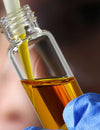
At Best Before E-Liquid, we’re dedicated to not only providing you with amazing deals and bargains on your favourite high-quality e-liquid brands, but also in helping to educate the vaping sector and its customers on the real truth behind the “Best Before” Date. In this blog, we’ll put our safety goggles and lab coat on, and take you on an intellectual journey through our research into “expired” e-liquids, which has formed the concept behind Best Before E-Liquid.
As we explored in our previous blog, the use of best before dates for e-liquids has come directly from the food industry, where products also have a “Use-By Date”. As explained by the name, a use-by date dictates to the consumer the final date by which they should use the product. After this date, the UK’s Food Standards Agency state that the food product should not be eaten, cooked or even frozen. In comparison, the best before date refers to quality and not safety - the FSA state that food past its best before date “will be safe to eat after this date but may not be at its best. Its flavour and texture might not be as good.”
For e-liquids, the best before date is normally a calculated date of two years from the Date of Manufacture (DoM) displayed on the e-liquid packaging. This can cause a lot of customer confusion at times when a customer states an e-liquid has gone out of date. On the vast majority of occasions, the date quoted on the e-liquid packaging is the date of manufacture, and not a best before date. We’re not surprised that vaping customers are uncertain about what date means what!
Enter the Best Before Lab
So, without reiterating the entirety of our first blog, let’s get geeky. At Best Before E-Liquid, we’ve applied our flavour science understanding and knowledge of product development within both the food and vaping retail industry to highlight some key flaws in current market thinking. When it comes to the handling of e-liquid products past their best before date, you can tell from our name that we’re massive advocates for consumer education surrounding best before dates. But apart from just simply comparing e-liquid best before dates to the best before dates on the foods in your fridge, you may be wondering if we’ve done any research into what really happens to your e-liquid. Well, you’re in luck.
Take a seat on a lab chair, goggle up and let’s walk you through the technical stuff. We’ve performed multiple tests on a range of different e-liquid brands to investigate the effects of shelf life, analysing e-liquids close to or over their best before date to understand and know the quality of the e-liquid, and whether it’s still great to vape.
The quality of an e-liquid is mainly down to the perception of appearance (colour), flavour (aroma and taste) and thickness (viscosity). Whilst we test the aroma and taste of our e-liquids by individually taste-testing each batch, in the Best Before lab, we use our scientific understanding and analytical chemistry techniques to determine the quality and safety of the e-liquids we stock, which have been in our warehouse facility for an extended storage period - equal or over two years.
Our Testing Process
We’ll delve deeper into one of our most recent tests to explain a little better about the technical processes we follow, in relation to appearance, nicotine strength and safety in line with government regulations. Within this test in particular, we took several different batches of a well-known e-liquid brand, focusing on the Tobacco flavour for continuity. Covering a range of different nicotine strengths, we selected products with different dates of manufacture, from freshly manufactured to manufactured over four years ago. The tobacco e-liquid samples were randomly selected from each batch of finished e-liquid goods stored within our temperature-controlled warehouse.
Test Part 1: Appearance
The freshly manufactured nicotine e-liquid samples were clear in appearance, with a slight colouration of pale straw yellow. As the e-liquids were stored over time, the colour changed from straw yellow, to yellow-orange, and then finally to a dark orange liquid. To help you imagine this a little better, we’re describing the transition in colour from Robinson’s Lemon Squash to Fanta, to Irn Bru. In samples with a high nicotine strength, the appearance of these e-liquids became even darker over time.
One of the main reasons for this colour change is a very common process called oxidation, which can be accelerated by elevated temperatures and direct sunlight. Without getting into the science too much, the atoms of the nicotine molecule interact with the atoms of the oxygen molecules in the air. If you’ve been vaping for a while, you might notice that an e-liquid you leave on a warm, airy windowsill looks different to one you’ve popped into a drawer.
This colour change due to oxidation is completely normal, expected and accounted for in most e-liquid products. In fact, when an e-liquid is first manufactured, the liquid goes through “steeping” to obtain the best possible flavour and throat hit for the customer, so it’s important to emphasise that this process is not a bad one!
So what does this mean for you? Oxidation is a natural chemical reaction that does not alter the taste or overall vaping experience, which is why your e-liquid past its best before date is still perfectly fine to vape regardless of its colour.
Test Part 2: Nicotine Strength
So we’ve explained the colour change you may notice within your liquids. What’s next? The nicotine strength, of course!
We performed analytical concentration testing of nicotine on the four-year-old manufactured e-liquid samples within our Tobacco batch, specifically selecting the highest strength this brand supplied, which were stated to be 18mg. When measured for nicotine levels, the four-year-old samples gave very similar nicotine values (approximately 18mg) to the freshly manufactured e-liquid samples (also approximately 18mg when measured with our equipment).
The nicotine test demonstrates that there is no significant loss or gain in the overall nicotine strength or nicotine hit, even within the four-year-old samples. With samples much older than this, oxidation may cause the nicotine strength to be slightly reduced, or find the throat hit to be slightly harsher or smoother depending on the liquid itself. This does not mean that your e-liquid is any less safe to vape, but that it might be slightly less satisfying.
Test Part 3: Are There Any Nasties?
In the final part of this specific test, we performed further analytical testing using an impressively geeky chemistry technique called Gas-Liquid Chromatography, or GLC if you want to sound hip. This testing ensured each age of e-liquid had no dangerous chemicals as prohibited by the Tobacco and Related Products Regulations 2016 or TRPR. The GLC testing demonstrates the high quality and the safe nature of all the bulk ingredients (Vegetable Glycerin and Propylene Glycol) and complex flavours used in the products we’re proud to bring to you at Best Before E-Liquid.
Final Words from the Technical Team
In summary, we’re proud to say that the e-liquids available at Best Before E-Liquids are scientifically tested and truly great to vape! In conjunction with our testing in the laboratory, the Best Before E-Liquid team taste test each batch of e-liquid before it goes on sale on our website.



